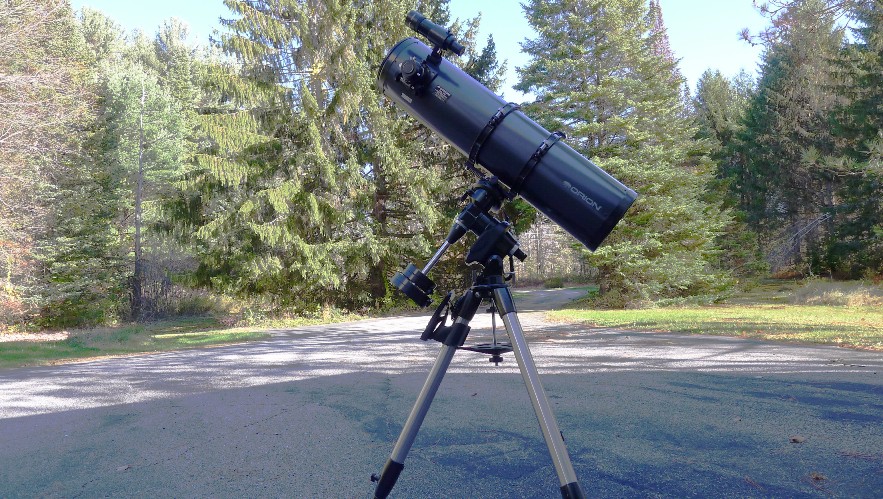
Updated 11/3/16
1) Orion 8" f/5 Newtonian OTA (aka Meade, Celestron, and many others) 11/2/16, 11/3/16
(NLA, available on the secondary market ~$250-$400 street, 8X50 finder, 2" focuser, rings, plate)
This Chinese Synta-based OTA has been available for at least the past ten years under various guises. Orion sold them in the mid-2000s with Sky View Pro/Deluxe mounts for $599, or with the original non-Goto Atlas for $1200. Since then, these 8" f/5 tubes have appeared in a number of guises from various manufacturers. I've seen them sold with mounts, and the way I got this one - with rings, plate, 8X50 finder, and the standard Synta "pinch your fingers" focuser. As of this writing, versions of it can be found as an LX70 by Meade, or coupled with an AVX mount from Celestron. These OTAs show up on the used market, often at very attractive prices. (Update 11/3/16: An updated version of the scope is still available from Orion. They don't advertise it heavily so you have to look for it. Do a search on their web site for "203mm f/4.9." It's available in a number of different configurations. You can get the OTA only, or you can get it coupled with a Sky View Pro, Sirius, or Atlas mount. The new scope appears to be very similar to the one tested here, except it now has a Crayford-style focuser.)
So remember I mentioned in the previous review of the AR127 to be suspicious whenever you need more than the stock 11 lb counterweight on a CG-5 or an AVX? Ehhhhhh.......forget about that for a few minutes, okay? The 8" f/5 OTA is heavy - I got it to balance (barely) with the 11 lb and 7 lb weights, but for the majority of my testing, I felt more secure using two 11 lb counterweights. Did the scope sway in the wind a little? Did it take a little while to settle down at higher powers? Yes, it did, but as my friend Mike likes to say, it wasn't evil about it. Still, unlike some of my more portable setups, I had to plan exactly where I wanted to scope to sit on a particular night before actually setting it down.
This OTA sample doesn't have good optics. I feel strange typing that, because it's been a while since I've seen any telescope with subpar optics. We've gotten spoiled. Everything is so good these days. There was a general softness to the images; stars would refuse to focus down to points. The star test revealed a rather large and uncomfortable amount of undercorrection. The owner began to suspect the mirror had a turned edge (which, if you stop and think about it, could be interpreted as a form of severe undercorrection.) The problem with a turned edge is that the edge constitutes a large area of the mirror. With nothing to lose, the owner decided to make a small ring to mask the outer portion of the mirror. This only takes a few minutes (see sidebar, below) and the process is easily reversible. With this particular mask in place, the scope turns into a ~7.25" inch ~f/5.4 Newtonian.
Did this help? You bet it did. The star test still shows undercorrection, but it's within reasonable levels. The way I read the mirror, the results look a little like the 1/2 wave illustrations in Suiter's book. That's not great, but it's an improvement, and it's good enough that I feel the scope is usable for most of its intended audience.

Orion's 8" f/5 Newtonian OTA, on a CG-5
With the CG-5's legs fully retracted, the eyepiece sits at a convenient height, and I rarely felt the need to rotate the rings. In mid-autumn 2016, we had a stretch of nice clear weather. I stayed up and did a lot of imaging and observing. I can report very little problems with the optics, even at "1/2 wave" error with its aperture mask in place. M13 will show some resolution in its outer members, and M92 takes on its odd elliptical shape (things in space have a tendency to want to be spheres, and I've always found M92 to be an oddity in this regard.) All of the showpiece fall objects are easy - M27, M57, Albireo, M31, M15, M56, and others fell easily to the 8" Orion. With a nice wide-field eyepiece like a 27 mm Panoptic, sweeping the Milky Way is a pleasure.
It was only when trying to split double stars that I ran into some minor difficulty. Albireo and Mizar/Alcor were easy, for example, but while I was able to split Eta Cass, the red-colored secondary seemed to want to bleed a little into the primary. Gamma Andromeda was easy (no "B" pair though!) The double-double was split, but not as cleanly as in the Explore Scientific AR127 refractor (see previous review.) And I could never achieve a split on Delta Cygnus over successive nights, no matter what eyepiece I tried (the owner of the scope says he has split Delta Cygnus with it, however.)
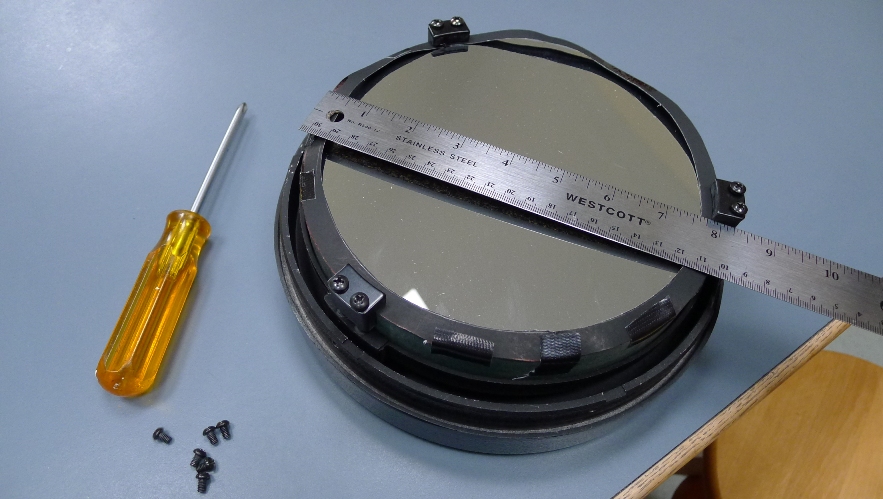
The masked off mirror in its cell
The undercorrected/turned edge mirror might have had a minor issue with contrast as well. I had no trouble seeing M31 and M33, but I felt the contrast was better in the AR127, and I while I found the HII region in M33, it's a little easier to see in my Orion XT8. The same hold true for dim little spindly NGC 891 in Perseus. NGC 404 sits right next to Beta Andromeda, and it's a good test of your scope's contrast. Again, while I was able to see the little NGC galaxy, some of the light from nearby bright Beta intruded a little more than I expected. And despite having far less aperture, I felt the AR127 did a better job pulling in the Veil Nebula (I didn't use a filter with either scope.)
Did the reduced aperture from the mask hinder the scope's performance on the above objects? I don't think so. One night I set the 8" f/5 next to my XT8. The differences in image brightness was, I felt, minimal. You'd have to have the two side by side to see the difference. However, my XT8 sharper, and the aforementioned AR127 refractor had better contrast.
The bugaboo for someone in the market for a mid-sized Newtonian is that the Orion XT8 (and its clones) casts a commanding shadow over its peers. As of this writing, $369 buys you a new XT8, which is all the scope many of us are likely to need. I've seen clean used samples selling around $250. Even with a house full of telescopes, my XT8 still gets used more than any of the others. But if you must have an equatorially mounted 8" Newt, this OTA will do the job. I will point out that if I had to choose, I'd take the Explore Scientific AR127 over this OTA. And what about the turned edge on this sample? Did the owner simply "luck out" and get a mirror at the lower end of the bell curve, or is this an issue with many of these? I can't tell. Orion hasn't sold these in a while; maybe the new versions are better, I don't know. But I can say that I've had at least minor issues with nearly every mass-produced mirror operating below f/6. This includes my 4.25" and 6" Starblasts, and the various 6", 8", and 10" f/4 imaging Newtonians I've seen (check elsewhere on this site, they're all reviewed here.)
-Ed
Sidebar: DIY Project - Unhappy with the performance of your fast Newtonian? Make an aperture mask.
While I use and like my little 4.25" f/4 Orion Starblast, I've always been a little disappointed by its optics. Seeing what the owner of the 8" f/5 did (above) I decided to try it myself. Here are the tools you need. It isn't hard. You'll need a screwdriver, scissors, a compass, and a masking material (I bought a package of multi colored cardstock from Wal-Mart for $3.99.)
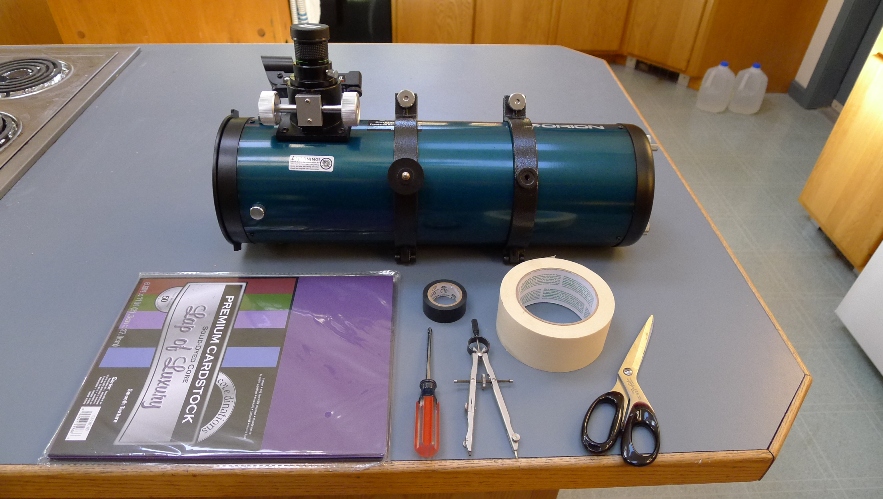
Before you remove the mirror, mark the spot so you can reinstall the mirror cell to the same orientation.
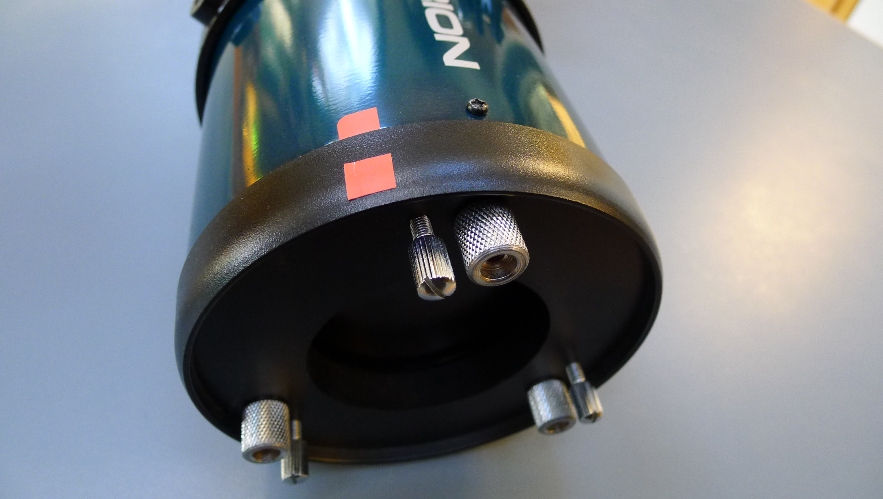
The mirror cell is usually held in place with three screws (six in the case of the Orion 8" f/5.)
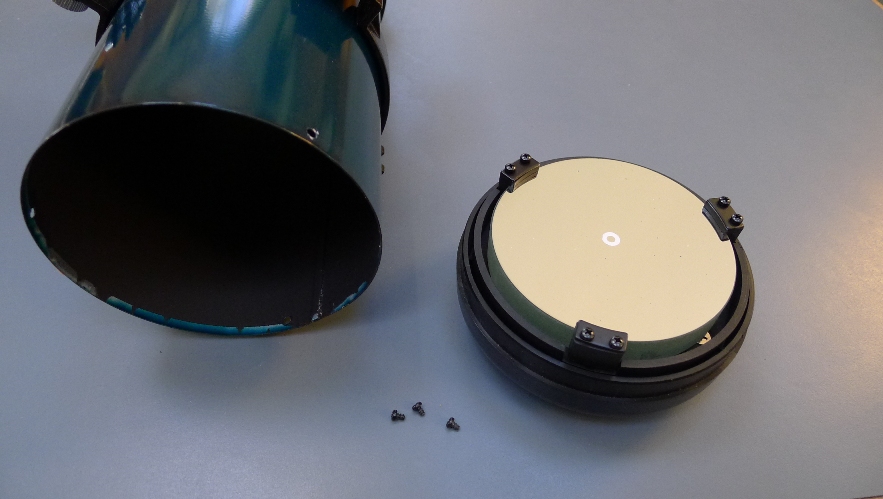
Draw a circle on the cardstock that matches the outer diameter of the mirror. BTW, my "114 mm" mirror actually measured out at only 112 mm.
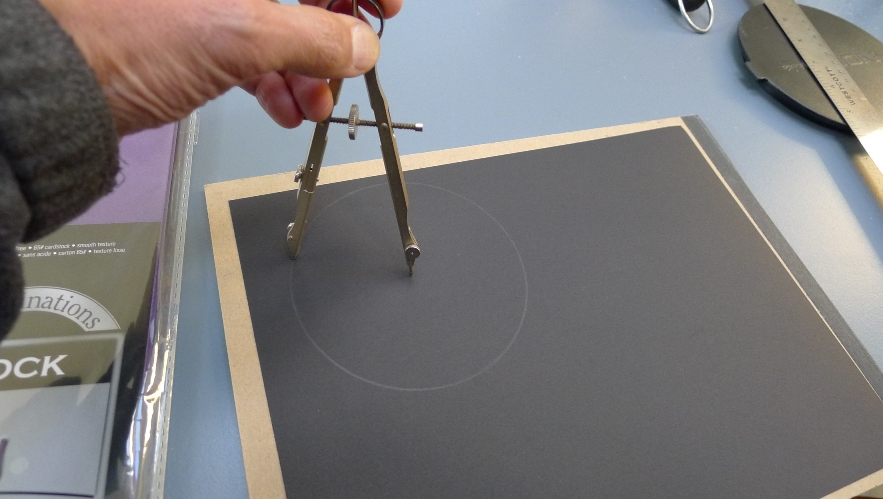
Here's the part I can't teach you. How much to mask off? You decide. I decided to take off enough to make the mirror into a 4" (100 mm.)
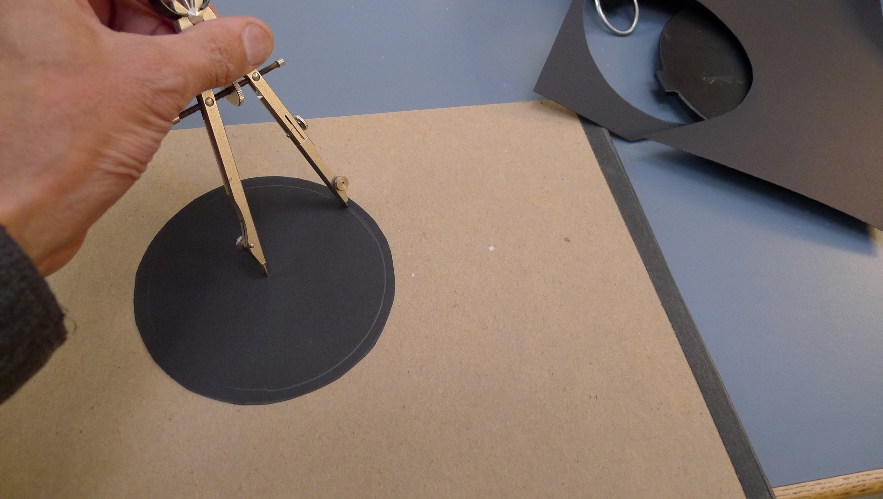
The aperture mask.
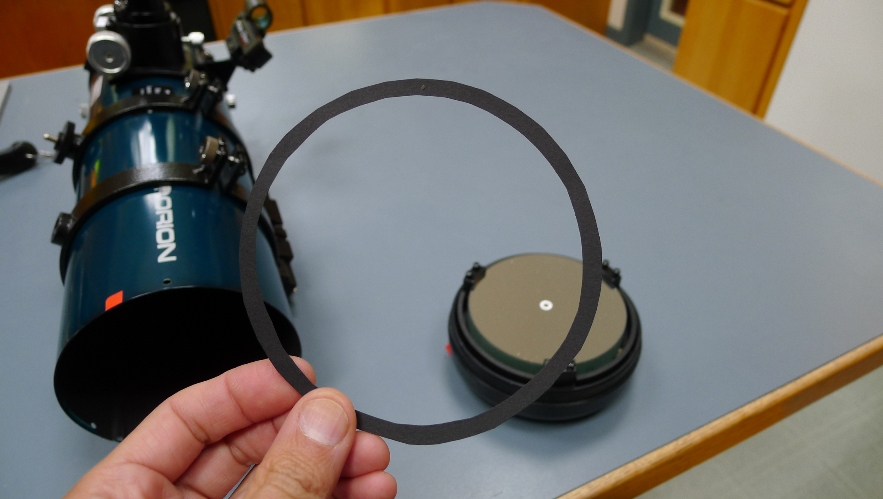
It doesn't look like I've done much here, but I've just turned the mirror from a 4.25" f/4 to a 4" f/4.5 by installing the mask.
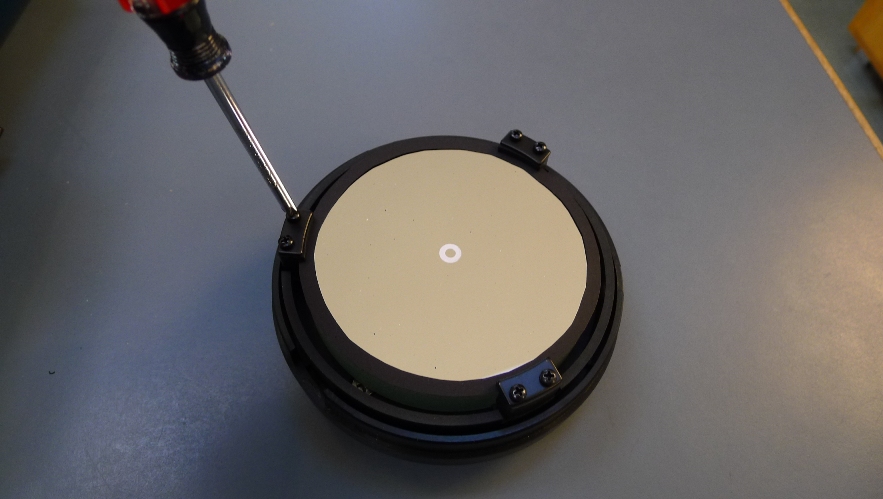
That's all there is to it. I can report that the little Starblast's performance has gone up, and with minimal loss of image brightness. If you wind up doing this, drop me a line and let me know how you did!
-Ed